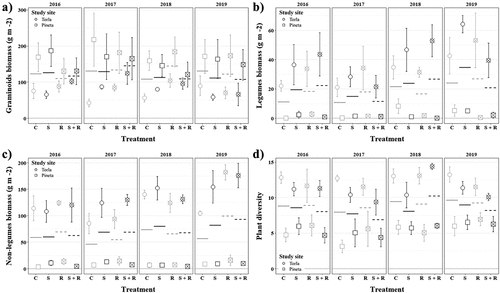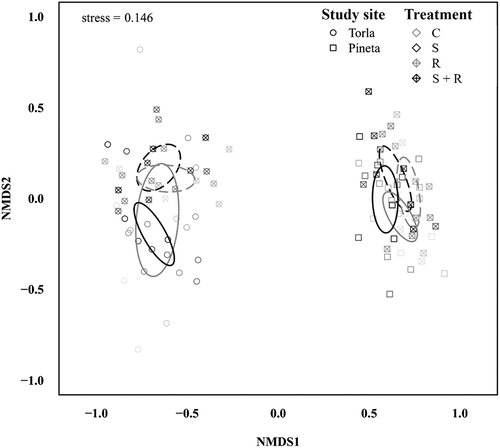Figures & data
Table 1. Location, elevation, climatic parameters (i.e., mean potential solar irradiation, mean of maximum and minimum temperatures, mean snow cover and mean annual rainfall) and percentage of rainfall blocked by rain-out shelters at each study site.
Table 2. Grassland biotic parameters (i.e., mean species richness, Shannon diversity index and relative abundance of graminoids, leguminous forbs, nonleguminous forbs and woody species) at the subplot level per study site.
Figure 1. (a) February’s minimum soil temperature (mean ± SE) and (b) July’s soil water content (mean ± SE) per study site, treatment and year. Horizontal lines indicate mean values per treatment and year. Symbol shape indicates study site (circle and square for Torla and Pineta, respectively), symbol/line color indicates snow removal treatment (gray and black for no snow removal and snow removal, respectively) and symbol/line pattern indicates reduced precipitation treatment (solid and dashed for no reduced precipitation and reduced precipitation, respectively). C, control, gray solid line; S, snow removal, black solid line; R, reduced precipitation, gray dashed line; S + R, snow removal plus reduced precipitation, black dashed line.

Table 3. Results of statistical analyses for the effect of treatment (i.e., C, S, R and S + R), study site (i.e., Torla and Pineta) and time on minimum soil temperature of the coldest month (i.e., February), soil water content of the warmest month (i.e., July), aboveground productivity, plant diversity (i.e., effective number of species) and species composition. Significant effects (p < .05) are highlighted in bold. Residuals Df = 83.
Figure 2. (a) Graminoids aboveground dry biomass (mean ± SE), (b) leguminous forbs aboveground dry biomass (mean ± SE), (c) non-leguminous forbs aboveground dry biomass (mean ± SE) and (d) plant diversity (effective number of species, mean ± SE) per study site, treatment and year. Horizontal lines indicate mean values per treatment and year. Symbol shape indicates study site (circle and square for Torla and Pineta, respectively), symbol/line color indicates snow removal treatment (gray and black for no snow removal and snow removal, respectively) and symbol/line pattern indicates reduced precipitation treatment (solid and dashed for no reduced precipitation and reduced precipitation, respectively). C, control, gray solid line; S, snow removal, black solid line; R, reduced precipitation, gray dashed line; S + R, snow removal plus reduced precipitation, black dashed line.

Figure 3. Nonmetric multidimensional scaling (NMDS) ordination plot of Bray-Curtis dissimilarities among subplots’ species composition. Symbol shape indicates study site (circle and square for Torla and Pineta, respectively), symbol/line color indicates snow removal treatment (gray and black for no snow removal and snow removal, respectively) and symbol/line pattern indicates reduced precipitation treatment (solid and dashed for no reduced precipitation and reduced precipitation, respectively). C, control, gray solid line; S, snow removal, black solid line; R, reduced precipitation, gray dashed line; S + R, snow removal plus reduced precipitation, black dashed line. Higher drawing intensity indicates more recent data and vice versa. Ellipses indicate 95 percent confidence intervals.

